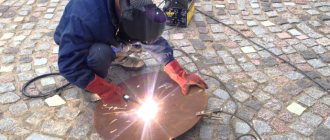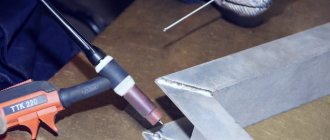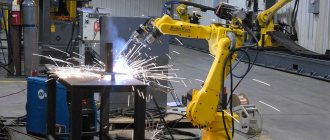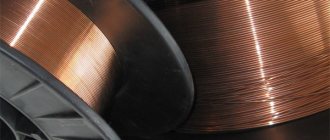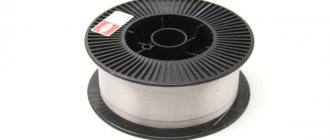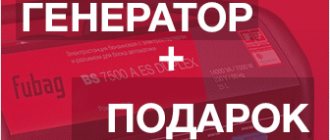Main characteristics and advantages
A wire with powder is an endless electrode, in which the role of a coating is performed by a composition inside a metal tube . Powder welding is performed under submerged arc without the use of additional installations for its supply. Inside the metal tube there is a mixture of crushed iron, its oxide, phosphates, chromium and other components, which:
- stabilize the temperature in the bath and around the arc to the optimal temperature for a particular material;
- promote mixing of molten metal parts and electrode;
- uniformly cover the entire width of the seam from contact with oxygen and nitrogen;
- make the bath boil evenly, without splashing;
- allow you to increase the speed of welding parts.
Flux-cored wires can be used to surfacing parts on the surface and welding in any spatial position in a specially equipped place and in the field.
Activated wire
For welding in a gas environment, a special wire is used, which is called activated. It contains salts of alkaline earth and alkali metals, which are easily ionized.
The wire sheath is made of Sv08G2S steel, which is thicker than flux-cored wire, and inside there is the specified filler powder in an amount not exceeding 7% of the weight of the sheath. This allows you to stabilize the arc and form a high-quality seam during welding.
Composition details
The outer body - the cylinder - is made of ductile low-carbon steel. Inside it is a special mixture, which includes:
- gas-forming and slag-forming charge;
- deoxidizers;
- stabilizing elements;
- alloying components.
Manganese, nickel, rutile concentrate, and marble powder are used as the charge . Chromium, aluminum, copper and other substances used for alloying steels are added to the material for welding alloy and stainless steels. Iron powder is used to stabilize the bath.
In addition, depending on the purpose of the wire, magnesite and fluorspar are added to the powder composition.
When working with refractory materials, wire containing graphite and aluminum powder is used, which increases the temperature in the bath and around the arc.
The best manufacturers
Today, even the most picky buyer knows which company’s product is best to buy. In our case, the “Name” of the manufacturer is also of great importance. Moreover, there are quite a lot of manufacturers on the modern market and this somewhat complicates the choice. We are only interested in quality products, so we will get to know the best manufacturers from different countries.
Russia
Leopard
Filler materials of this brand have been produced by Barsweld since 2008. In terms of the characteristics of the final product, they will compete with any European manufacturer. The company's assortment includes various types of consumables, including: stainless, aluminum, copper, copper-plated, powder. Modern equipment from Europe ensures high final quality of the product.
CHZSM
In 2012, the production of filler rods began at the Cherepovets Welding Materials Plant. Today it is one of the leaders among domestic manufacturers, equipped with the most modern equipment and highly qualified personnel. The range of brands and diameters is quite wide.
Svarmontazhstroy (SMS)
Russian company from Dolgoprudny in the Moscow region. Produces solid wire at world standards. The product is in high demand among shipbuilders, mechanical engineering enterprises and engine manufacturers, energy complex enterprises, etc. The quality control and management system is based on compliance with the provisions of the international standard ISO 9001:2015. There are two options in the range: copper-plated and Ultra (without coating, with improved surface characteristics).
Sudislavsky Welding Materials Plant
Production is launched in the Sudislavsky district of the Kostroma region. The main activity is the production of electrodes. In 2011, the plant commissioned a technological line for the production of two types of wire:
- copper-plated, polished with graphite coating, with a diameter from 0.8 to 1.6 mm for work in a gas environment;
- copper-plated for different grades of steel, with a diameter from 2.0 to 5.0 mm, for welding with flux.
The company's products are in high demand
China
Rods made in China are in high demand due to their decent quality and budget price. There are a significant number of Chinese manufacturers on the market. Let's get to know some of them.
DEKA
The company produces and supplies the market with inexpensive and high-quality welding consumables of its own production. Her product is intended for semi-automatic and argon devices.
Farina
The company is engaged in the production of wire for joining parts made of low-alloy and carbon steels. The material is in demand in various industries. The consumable from Farina is characterized by its low cost, stable thickness, and fast ignition of the arc. To preserve the working qualities of the goods during long-term transportation, sealed packaging is used.
Sweden
ESAB
The world leader in the production of welding materials is of Swedish origin. Its products are in high demand among welders around the world. The range of brands is extremely wide. Polished wire from ESAB is in particular demand. The company owns more than two dozen factories in Europe, Asia, and America.
Elga
Swedish company. On the market since 1938. The range includes all types of filler materials. The company's products are used mainly for the assembly of critical structures. The plant's equipment is the most modern. There is a research center and laboratory where new technical solutions are developed.
Italy
Quattro Element
The manufacturer is known for reliable and high-quality products and a wide range of products, including stainless, flux-cored, aluminum and copper-plated filler rods. According to welders, some of them are the best in the world.
Novofil SRL
The company is rightfully considered one of the world leaders in the production of wire for working with low-alloy, low-carbon aluminum products. Copper and bronze coated materials are produced. The product quality is consistently high.
USA
Lincoln Electric
Products for semi-automatic welding from this American company guarantee a stable arc and high productivity. They are in high demand among craftsmen all over the world.
Hobart Brothers
Solid, powder and aluminum filler rods from the American company Hobart Brothers are in high demand. The promotion of their products on the world market is carried out exclusively by company managers in sales offices around the world.
Principles of classification
According to the shape of the shell, tubes made of metal sheets are distinguished:
- round, with edges joined end-to-end;
- with lock-type bends;
- multilayer.
According to the use of a protective environment, a distinction is made between PP - gas-protective, flux-cored wires for welding in a gas environment and PS - self-protective, which does not require additional consumables.
In addition to indicating the type of wire, the marking uses a letter designation of the spatial position of the seam, which is performed with this electrode.
Steel grades are not reflected in the markings ; they must be looked at in the technical specifications for each type of cored wire.
Gas-protective
The gas shield wire requires covering the top of the weld pool. For this, argon or other inert gas is used. Used for welding carbon and low-alloy steels . It has positive technical characteristics and advantages over other electrodes:
- stable arc;
- slag easily comes to the surface;
- no porosity;
- low spatter;
- the slag is easily separated.
PP is characterized by deep penetration. It is used to create butt, corner and overlap joints when creating metal structures and pipelines .
Self-protective
Self-shielding wire for a semi-automatic machine is suitable for working in any spatial position of a seam in field conditions. It does not require any additional consumables. During operation, a cloud of molten gas-forming charge forms above the bath. An even layer of flux is applied to the seam, completely covering the hot joint in a wide strip.
PS is used for welding outside equipped places , outdoors for welding alloy steels, stainless steel, non-ferrous alloys and cast iron. And also for soldering various parts made of aluminum and its alloys. Stainless steel is welded with electrodes containing a high content of chromium, nickel and ferromanganese in the core.
Which is better – welding wire or electrodes?
In both cases, these materials make it possible to make a durable and high-quality seam. One way or another, the welding wire essentially plays the role of an electrode during welding.
However, the methods of working with these materials are different:
- Electrode rods are coated and provide alloying of the weld metal not only due to the metal of the rod, but also through the composition of the coating. Alloying in the case of wire is provided only by its metal.
- Wire welding is always a mechanized process, semi-automated or fully automatic.
- When welding with electrodes, a protective gas environment is not required. In addition, it can be carried out in hard-to-reach places - directly on the construction site, which is impossible or difficult in the case of stationary machines.
However, in some types of work it is necessary to use welding wire. For example, when welding stainless metals, which in itself is quite labor-intensive. Only wire will allow you to achieve an ideal and precise seam in welding vertical structures.
Unlike electrodes, the wire does not need pre-calcination, which speeds up the process and does not require additional equipment. In addition, this material is much cheaper than coated electrodes.
It must be remembered that the exact choice of additive may require extensive knowledge. Before starting work, you need to study all the features of the material, check the expiration dates of the welding wire and, if necessary, consult with more experienced welders.
Production Features
To produce cored wire, a sheet with a thickness of 1.18 - 0.25 mm is cut lengthwise into strips.
The filler is prepared separately, mixing all the components of the core in certain proportions. Wire production occurs in several stages in one installation.
- Cleaning the strip from dirt, oil, scale and moisture at the beginning of the machine.
- Slight longitudinal deformation of the pipe with the formation of a semicircle.
- Filling the strip with powder.
- Connecting the ends, forming a tube with flux.
- Calibration of the connection and the profile itself. Creating a regular circular section.
In modern welding production, welding strips made of low-carbon steels are most often used.
During manufacturing, the wire is not joined and rolled to the length of the strip. There should be one solid piece on the reel.
To remove moisture and oil from the surface of PP and PS, the coil should be placed in an oven before installation on the device. Maintain for 2 hours at a temperature of 230 - 250⁰.
Flux-cored wire designs.
Of the flux-cored wire designs used (Fig. 4 ), the most common are tubular wires ( a, b, c ). The introduction of part of the shell into the core ( d, e, f, g, h ) ensures more uniform melting and more effective protection of the metal from air.
Rice. 4 . Flux Cored Wire Designs
The influence of the wire design on the characteristics of its melting and the properties of the seams is discussed below.
Description of popular brands
When welding metal structures and pipelines on a construction site, the most commonly used grade is PP-AN11 or PP-AN7, which has similar characteristics. In production, a tape with a thickness of 0.18 mm is used. The charge contains slag-forming elements.
The welding mode is semi-automatic, current with reverse polarity. Shielding gas argon and helium or a mixture thereof .
When a conditional ceiling passes through a vertical into the floor, for example when welding pipes with a continuous seam and critical structures, experts recommend the PP-AN19 grade for low-carbon steels. When welding, the amount of slag is much greater. It holds well on verticals and ceilings.
The stainless metal is joined using PP-2VDSK, the core of which contains large amounts of nickel. Protective medium – inert gases.
Instructor of welding divers of the team for repairing the underwater part of ship hulls Kireev D.V.: “For underwater welding, PS with a special composition, manufactured in accordance with GOST 5278-74, is used. The powder contains up to 24% aluminum powder, 6% graphite and 75% iron oxide - scale. Graphite provides a stable arc at low currents. Aluminum enhances the exothermic effect, preventing surrounding water from penetrating into the bath. Iron oxides melt and create a slag protection. With straight polarity, cutting can be done underwater.”
Flux-cored wire for surfacing: grades, main parameters and dimensions
Grades of flux-cored surfacing wires according to GOST 26101-84 (in brackets - old designation, italics - grades added by change No. 1):
PP-Np-200Kh12M (PP-AN103), PP-Np-200Kh12VF (PP-AN104), PP-Np-90G13N4 (PP-AN105), PP-Np-10Kh14T (PP-AN106), PP-Np-18Kh1G1M ( PP-AN120), PP-Np-30Kh5G2SM (PP-AN122), PP-Np-200Kh15S1GRT (PP-AN125), PP-Np-30Kh4G2M (PP-AN128), PP-Np-25Kh5FMS (PP-25Kh5FMS), PP -Np-25Kh5FMST (PP-AN130), PP-Np-30Kh4V2M2FS (PP-AN132), PP-Np-10Kh17N9S5GT (PP-AN133), PP-Np-250Kh10B8S2T (PP-AN135), PP-Np-10Kh15N2T (PP -AN138), PP-Np-30Kh2M2FN (PP-AN147), PP-Np-200KhGR (PP-AN160), PP-Np-40Kh4G2SMNTF (-), PP-Np-100Kh4G2AR (-), PP-Np-80Kh20R3T ( PP-AN170), PP-Np-150Kh15R3T2 (PP-AN170M), PP-Np-350Kh10B8T2 (-), PP-Np-35V9Kh3SF (PP-3Kh2V8), PP-Np-45V9Kh3SF (PP-4Kh2V8), PP-Np -14GST (PP-TN250), PP-Np-19GST (PP-TN350), PP-Np-50Kh3ST (PP-TN500), PP-Np-35Kh6M2 (PP-8-ZhN), PP-Np-12Kh12G12SF (PP -35-ZHN).
Classification of flux-cored surfacing wires by manufacturing accuracy (classes)
| Nominal wire diameter, mm | Maximum deviation for wire, mm | |
| 1st class | 2nd class | |
| 1,8 2,0 | -0,08 | -0,10 |
| 2,2 2,6 2,8 | -0,10 | -0,12 |
| 3,0 3,2 3,6 | -0,15 | -0,18 |
| 4,0 5,0 6,0 | -0,18 | -0,20 |
Wire symbol in accordance with the design
| Construction (wire cross-sectional shape) | Name | Symbol |
| Tubular butt | T | |
| Tubular with overlapping edges | N | |
| Double layer | D |
Wire symbol in accordance with the surfacing method
| Surfacing method | Wire symbol |
| Submerged Surfacing | F |
| Surfacing in shielding gases | G |
| Surfacing without additional protection (self-protecting) | WITH |
| Submerged arc surfacing, in protective gases and without additional protection (universal wire) | U |
An example of a symbol for flux-cored surfacing wire brand PP-Np-80X20R3T , tubular butt, self-protecting, 3.2 mm in diameter, 1st class:
PP-Np-80Х20Р3Т-Т-С-3,2-1 GOST 26101-84
PP - flux-cored wire, Np - surfacing wire. The first figure is the average mass fraction of carbon in the deposited metal in hundredths of a percent. The numbers behind the letters indicate the average mass fraction of the element in percent. The absence of a number means that the average mass fraction of the element is no more than 1.0%. If the silicon content is less than 0.8% and manganese less than 0.1%, the letter designation is not affixed.
Grades of flux-cored surfacing wires: compliance with designs, surfacing methods and diameters (recommended).
To the begining
The essence of arc powder welding
When welding with flux-cored and self-shielding wire, the body and the metal powder included in the filler melt. They fill the seam, connecting with the molten metal of the edges of the parts.
The flux contained inside melts and closes the bath from oxidation and combination with nitrogen . In self-shielding wire, it completely closes the seam, slowing down the cooling rate of the metal and allowing slag, gases, and moisture to come to the surface. A strong crust is formed on top along the entire width of the seam, which is easily removed when cold.
Technology and some of its disadvantages
Flux-cored welding wire is welded on semi-automatic machines and used on automatic lines . The consumable material is fed into the welding zone at a constant speed. The arc heats the bath and distributes the melt evenly in a non-contact manner - without touching the edges of the parts being joined.
The welding process is carried out using alternating current, the polarity is reversed. The quality of the seam complies with GOST 26271-84. Uniform wire feed and a stable arc allows you to make any seams of complexity, position and length without joints. Productivity is 2–4 times higher than when working with solid wire.
PPs are excellent at welding parts, but they also have the following disadvantages :
- relatively high cost;
- narrow specialization of each brand of consumables;
- it is difficult to weld sheets up to 1.5 mm thick;
- low viscosity and ductility; when bent, the wire breaks;
- feeding is carried out by special rollers with reduced compression only;
- Only the pulling mechanism on the handle is used.
When welding with self-shielding wire, the weld pool is difficult to see under the submerged arc. The cost of powder welding is justified when applying long seams . When welding short sections, a lot of waste is left.
The use of flux-cored wire on semi-automatic machines significantly increases the productivity and quality of the seam. For home use with a small amount of work, it is expensive. In workshops and production, where you need to weld well and quickly, you can get by with the efforts of welders with low grades, without inviting expensive specialists.
Test methods. Package. Wire guarantees
Test methods for cored wire
The hardness of the deposited metal is determined by the Rockwell method (GOST 9013-589) or the Brinell method (GOST 9012-59). The arithmetic mean of at least three measurements is taken.
To check: relative wire consumption, chemical composition and hardness of the deposited metal, surfacing is performed on plates made of steel grade St3ps or St3kp, or St3sp according to GOST 380-71.
The plate size is at least 69 x 150 mm, thickness is at least 14 mm. Surfacing is performed using rollers 12-18 mm wide and 100-120 mm long for wires:
- types C and G - in three layers;
- for wires type F - in four layers,
on direct current of reverse polarity (“minus” on the sample), modes - table 4.
The deposited metal is processed by grinding.
Table 4 - Modes of surfacing with flux-cored wire during testing. Relative consumption of cored surfacing wire
| Flux cored wire grade | ø, mm | Surfacing modes during testing | Relates. wire consumption | ||
| Current, A | Ud, V | Deposition rate, m/h | |||
| PP-Np- 200Х12М -Т-Ф (PP-AN103) | 3,6 | 350-400 | 30-32 | 25-30 | 1,15 |
| PP-Np- 200X12VF -T-F (PP-AN104) | 3,6 | 350-400 | 30-32 | 25-30 | 1,15 |
| PP-Np- 90G13N4 -N-S (PP-AN105) | 2,8 | 220-240 | 20-22 | 20-30 | 1,25 |
| PP-Np- 10Х14Т -Т(Н)-С(Ф) (PP-AN106) | 2,8 | 260-320 | 24-26 | 15-20 | 1,30 |
| PP-Np- 18H1G1M -T(N)-F (PP-AN120) | 3,6 6,0 | 380-400 600-650 | 26-28 30-32 | 18-20 25-30 | 1,15 |
| PP-Np- 30H5G2SM -T(N, D)-U (PP-AN122) | 2,6 | 320-360 | 25-27 | 15-20 | 1,25 |
| PP-Np- 25Kh5FMS -T(N)-F (PP-25Kh5FMS) | 3,6 4,0 5,0 6,0 | 350-430 390-470 470-550 560-650 | 28-32 30-34 32-36 32-37 | 30-40 | 1,28 |
| PP-Np- 25Kh5FMST -T(N)-S (PP-AN130) | 2,2 2,8 | 259-300 320-360 | 24-26 25-27 | 12-15 15-20 | 1,25 |
| PP-Np- 30Х2М2ФН -Т(Н)-Ф (PP-AN147) | 3,6 4,0 5,0 6,0 | 350-430 390-470 470-550 560-650 | 28-32 30-34 32-36 32-37 | 30-40 | 1,10 |
| PP-Np- 200HGR -T-S (PP-AN160) | 1,8 | 160-180 | 19-20 | 8-12 | 1,20 |
| PP-Np- 40Х4Г2СМНТФ -Т-С (-) | 2,0 | 190-240 | 22-26 | 12-18 | 1,20 |
| PP-Np- 100X4G2AR -N-U (-) | 3,2 | 350-400 | 30-35 | 35-50 | 1,20 |
| PP-Np- 200X15S1GRT -N-S (PP-AN125) | 3,2 | 340-380 | 28-30 | 15-20 | 1,15 |
| PP-Np- 30Х4Г2М -Т-С(Ф) (PP-AN128) | 2,0 | 230-250 | 23-25 | 16-18 | 1,28 |
| PP-Np- 30H4V2M2FS -N(T)-F (PP-AN132) | 3,6 4,0 5,0 6,0 | 350-430 390-470 470-550 560-650 | 28-32 30-34 32-36 32-37 | 30-40 | 1,05 |
| PP-Np- 10Х17Н9С5ГТ -Т(Н)-Ф (PP-AN133) | 2,8 3,6 | 260-320 340-380 | 26-28 32-36 | 18-25 15-20 | 1,05 |
| PP-Np- 250Х10Б8С2Т -Н-С (PP-AN135) | 3,2 | 380-420 | 30-34 | 8-12 | 1,25 |
| PP-Np- 10Х15Н2Т -Н-У (PP-AN138) | 2,6 | 270-320 | 24-28 | 16-18 | 1,30 |
| PP-Np- 80Х20Р3Т -Н-С (PP-AN170) | 3,2 | 400-420 | 30-32 | 8-12 | 1,20 |
| PP-Np- 150X15R3T2 -N-S(F) (PP-AN170M) | 2,6 3,2 | 280-320 320-400 | 28-32 30-34 | 8-12 | 1,15 |
| PP-Np- 350Х10Б8Т2 -Н-С (-) | 2,6 3,2 | 260-300 350-400 | 26-30 28-32 | 8-12 | 1,15 |
| PP-Np- 35V9H3SF -T(N)-F (PP-3H2V8) | 3,6 4,0 5,0 6,0 | 350-430 390-470 470-550 560-650 | 28-32 30-34 32-34 32-37 | 30-40 | 1,05 |
| PP-Np- 45V9H3SF -T(N)-F (PP-4H2V8) | 3,6 4,0 5,0 6,0 | 350-430 390-470 470-550 560-650 | 28-32 30-34 32-34 32-37 | 30-40 | 1,05 |
| PP-Np- 14GST -T(N)-S (PP-TN250) | 3,0 | 260-320 | 24-26 | 15-20 | 1,25 |
| PP-Np- 19GST -T(N)-S (PP-TN350) | 3,0 | 260-360 | 24-26 | 15-20 | 1,25 |
| PP-Np- 50Х3СТ -Т(Н)-С (PP-TN500) | 3,0 | 260-320 | 24-26 | 15-20 | 1,25 |
| PP-Np- 35Х6М2 -Т(Н)-Ф (PP-8-ZhN) | 3,6 4,0 5,0 | 350-430 390-470 470-550 | 28-32 30-34 32-36 | 30-40 | 1,05 |
| PP-Np- 12Х12G12SF -T(N)-F (PP-35-ZhN) | 3,6 4,0 5,0 | 350-430 390-470 470-550 | 28-32 30-34 32-36 | 30-40 | 1,05 |
Flux Cored Wire Packaging
The weight of the wire batch should be from 100 to 20,000 kg.
Wire supplied:
- in skeins (must consist of one piece);
- on drums or reels according to GOST 25445-82.
Flux cored wire coil sizes
| Wire diameter, mm | Skein size, mm | Weight, kg | |
| Inner diameter | Outside diameter | ||
| From 2.00 to 3.60 inclusive | 150-250 | 350-400 | 3-60 |
| Over 4.00 | 250-350 | 450-500 | 5-80 |
